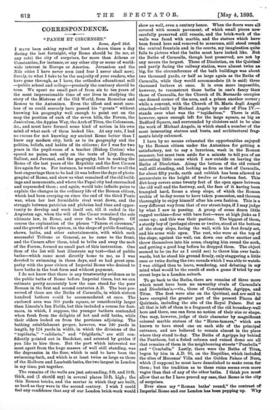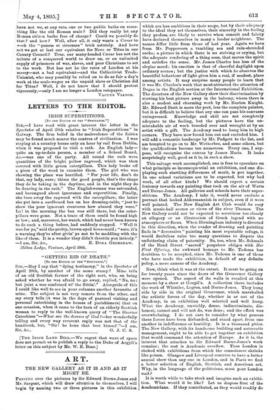CORRESPONDENCE.
" PANEM ET CIRCENSES."
Rome, April 21st. I HAVE been asking myself at least a dozen times a day during the last fortnight, why Rome should be (to me, at any rate) the city of surprises, far more than Athens or Constantine, for instance, or any other city or scene of world- wide interest in Europe or America. Jerusalem and the Nile cities I have never seen (and fear I never shall now). Surely, to what I take to be the majority of your readers, who have gone through, as I have, the orthodox educational mill —public school and college—precisely the contrary should be true. We spent no small part of from six to ten years of the most impressionable time of our lives in studying the story of the Mistress of the Old World, from Romulus and Remus to the Antonines. Even the idlest and most care- less of us could scarcely have passed his " greats " without knowing his geography well enough to point out on the map the position of each of the seven hills, the Forum, the Janiculum, the Appian Way, the Arch of Titus, the Colosseum, &c., and must have formed some kind of notion in his own mind of what each of them looked like. At any rate. I had no excuse for not knowing my ancient Rome better than I knew any modern city, both as to its geography and the politics, beliefs, and habits of its citizens ; for I was for two years in the pupil-room of a teacher (Bishop Cotton) who spared no pains, not only on the texts of Livy, Horace, Sallnst, and Juvenal, and the geography, but in making the Rome of the last years of the Republic and the first Cmsara live again for us. For instance, he would collect for us all the best engravings then to be had (it was before the days of photo- graphs) of Rome, and show us what remained of the old build- ings and monuments, and where the Papal city had encroached and superseded them ; and again, would take infinite pains to explain the changes in the ordinary life of the Roman citizen, which had been creeping on since the end of the third Punic war, when her last formidable rival went down, and the struggle between patrician and plebeian had time and oppor- tunity to develop and work itself out, till it ended in the Augustan age, when the will of the Cmsar remained the sole ultimate law, in Rome, and over the whole Empire. Of course the explanation of the phrase "Panem et circenses," and the growth of the system, in the shape of public feastings, shows, baths, and other entertainments, with which each successful Tribune or General, as he came to the front, and the Cwsars after them, tried to bribe and sway the mob of the Forum, formed no small part of this instruction. One item of the list will best illustrate my text—that of public baths—which came most directly home to me, as I was devoted to swimming in those days, and so had great sym- pathy with the poor citizen of Imperial Rome who desired to have baths in the best form and without payment.
I do not know that there is any trustworthy evidence as to the public baths of Rome before Imperial times, but we can estimate pretty accurately how the case stood for the poor Roman in the first and second centuries A.D. The best pre- served of these are the Baths of Caracalla, in which sixteen hundred bathers could be accommodated at once. The enclosed area was 360 yards square, or considerably larger than Lincoln's Inn Fields, but this included a course for foot- races, in which, I suppose, the younger bathers contended when fresh from the delights of hot and cold baths, while their elders looked on from the porticoes adjoining. The bathing establishment proper, however, was 240 yards in length, by 124 yards in width, in which the divisions of the " tepidaria," " calidaria," and "frigidaria," are still con- fidently pointed out in Baedeker, and attested by guides if you like to hire them. But the part which interested me most apart from the huge masses of wall still standing, was the depression in the floor, which is said to have been the swimming-bath, and which is at least twice as large as those of the Holborn and Lambeth baths, the two largest in London in my time, put together.
The remains of the walls are jest astounding, 8 ft. and 10 ft. thick, and (I should say) in several places 50ft. high ; the thin Roman bricks, and the mortar in which they are built, as hard as they were in the second century. I wish I could feel any confidence that any of our London brick-work would show as well, even a century hence. When the floors were alt covered with mosaic pavement, of which small pieces now, carefully preserved still remain, and the brick-work of the- walls was faced with marble, and the statues which have. been found here and removed to museums, still stood round. the central fountain and in the courts, my imagination quite fails to picture what the baths must have looked like. But the Baths of Caracalla, though best preserved, are not by any means the largest. Those of Diocletian, on the Quirinal and partly facing the railway station, were almost twice as, big, for the circumference of the bath buildings was about two thousand yards, or half as large again as the Baths of Caracalla, while they would accommodate (it is said) three thousand bathers at once. It is even more impossible, however, to reconstruct these baths in one's fancy than those of Caracalla., for the Church of St. Bernardo occupies one domed corner of the area, and a prison another corner ;- while a convent, with the Church of St. Maria degli Angeli attached—built by Michael Angelo by order of Pius IV— stands over what was the " tepidaiium." There is still, however, space enough left for the large square, as big as Bedford Square, and surrounded by cloisters said to be also the work of Michael Angelo, in which stand a number of the most interesting statues and busts, and architectural fin.- ments lately exhumed.
I have by no means exhausted the opportunities enjoyed by the Roman citizen under the Antonines for getting a satisfactory, not to say a luxurious, wash in the Roman summer, but must turn aside for a minute to tell you of an interesting little scene which I saw outside on leaving the- Baths of Diocletian. Along the bottom of the old ruined wall still standing, and looking as firm as that of Caracalla, for about fifty yards, earth and rubbish has been allowed to accumulate to the height of twelve or fourteen feet. This dirt-heap covers some twenty feet of the open space between the old wall and the footway, and, the face of it having been trampled hard, forms a steep slope, of which the Roman urchin of to-day seems to have taken possession, and thereon thoroughly to enjoy himself after his own fashion. This is a very different way from that of our street-boys, if I may judge by what I saw in passing. A group of some dozen little ragged urchins—four with bare feet—were at high jinks as I came up ; and this was their pastime. The biggest of them, a sturdy boy of (perhaps) eleven or twelve, stood at the bottom of the steep slope, facing the wall, with his feet firmly set, and his arms wide open. The rest, who were at the top of the slope, against the wall, ran down one after another and threw themselves into his arms, clasping him round the neck, and getting a good hug before he dropped them. The object seemed to be (so far as I could see) to throw him over back- wards, but he stood his ground firmly, only staggering a little once or twice during the two rounds which I was able to watch. I was obliged then to leave, wondering, and debating in my mind what would be the result of such a game if tried by our street boys in a London suburb.
To go back to the Baths, there are remains of three more which must have been no unworthy rivals of Caracalla's and Diocletian's,—viz., those of Constantine, Agrippa, and Titus. The first were also on the Quirinal, and are said to have occupied the greater part of the present Piazza de/ Quirinale, including the site of the Royal Palace. But as all that is left of them is a fragment of the old boundary-wall here and there, one can form no notion of their size or shape. One may, however, judge of their character by magnificent colossal marble statues of the "Horse-tamers," which are known to have stood one on each side of the principal entrance, and are believed to remain almost in the place where they stand to-day. The Baths of Agrippa lay behind the Pantheon, but a tinted column and ruined dome are all that remains of them in the neighbouring streets" Pumbella" and " Cumbella." Lastly, there were the Baths of Titus, begun by him in A.D. 80, on the Esquiline, which included the sites of Ma3cenas' Villa and the Golden Palace of Nero, which (I suppose) he must have demolished to make room for them ; but the tradition as to these rains seems even more vague than that of any of the other baths. I think you must allow that so far I have proved my case, that Rome is the city of surprises.
Ever since my "Roman baths' round," the contrast or Imperial Rome and our London has been popping up. Why
have not we, at any rate, one or two public baths on some- thing like the old Boman scale P Did they really let any Roman citizen bathe free of charge ? Could we possibly do that ? and how P Well, after all, it only wants a Caear to work the " panem et circenses" trick astutely. And have not we got at last our equivalent for Nero or Titus in our County Council ? True, our many-headed Cresar has not the tribute of a conquered world to draw on, or an unlimited supply of prisoners of war, slaves, and poor Christians to set to the work. But has not he the rates of London at his mercy—not a bad equivalent—and the Collectivist Trade- Unionist, who may possibly be relied on to do as fair a day's work at the scale-wages as the unpaid slave or Christian did for Titus? Well, I do not know that I should protest vigorously,—only I am no longer a London ratepayer.
Vaeuns VIATOR.







































 Previous page
Previous page